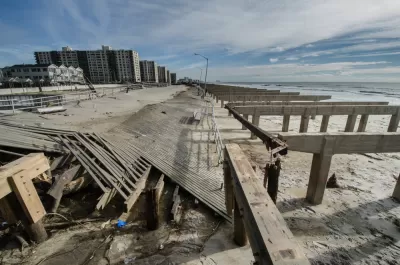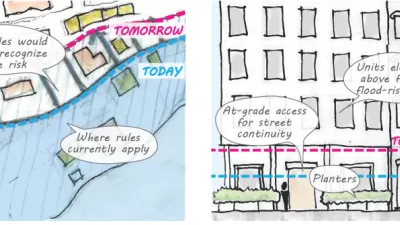The New York City Department of City Planning has released a large set of recommendations for zoning changes designed to help the city's many coastal areas weather the inevitable extreme weather events of climate change and sea level rise.

The New York City Department of City Planning (DCP) recently announced Zoning for Coastal Flood Resiliency, described in a press release as "a set of recommendations to help floodproof buildings in vulnerable neighborhoods against storms and incorporate sea level rise into their design as projected by the New York City Panel on Climate Change."
"Zoning for Coastal Flood Resiliency would expand the area where flood resilient zoning provisions apply, more than doubling the number of buildings that could utilize these provisions. It would accomplish this by allowing buildings in both the city’s 1% annual chance floodplain and 0.2% annual chance floodplain to fully meet or exceed flood-resistant construction standards, even when these standards are not required by FEMA and NYC’s Building Code," according to the press release.
The recommendations are a small step forward for the recommendations, following a public engagement process that briefed 2,500 stakeholders at 138 community events. "Environmental review and the formal public review process are anticipated to start before the end of the year," according to the press release.
The Zoning for Coastal Flood Resiliency recommendations are part of the Department of City Planning’s ongoing "climate resiliency initiatives." A lot more details about the recommendations are included in the press release and on a website set up to explain the recommendations.
FULL STORY: Department of City Planning Announces Zoning for Coastal Flood Resiliency

Alabama: Trump Terminates Settlements for Black Communities Harmed By Raw Sewage
Trump deemed the landmark civil rights agreement “illegal DEI and environmental justice policy.”

Planetizen Federal Action Tracker
A weekly monitor of how Trump’s orders and actions are impacting planners and planning in America.

The 120 Year Old Tiny Home Villages That Sheltered San Francisco’s Earthquake Refugees
More than a century ago, San Francisco mobilized to house thousands of residents displaced by the 1906 earthquake. Could their strategy offer a model for the present?

In Both Crashes and Crime, Public Transportation is Far Safer than Driving
Contrary to popular assumptions, public transportation has far lower crash and crime rates than automobile travel. For safer communities, improve and encourage transit travel.

Report: Zoning Reforms Should Complement Nashville’s Ambitious Transit Plan
Without reform, restrictive zoning codes will limit the impact of the city’s planned transit expansion and could exclude some of the residents who depend on transit the most.

Judge Orders Release of Frozen IRA, IIJA Funding
The decision is a victory for environmental groups who charged that freezing funds for critical infrastructure and disaster response programs caused “real and irreparable harm” to communities.
Urban Design for Planners 1: Software Tools
This six-course series explores essential urban design concepts using open source software and equips planners with the tools they need to participate fully in the urban design process.
Planning for Universal Design
Learn the tools for implementing Universal Design in planning regulations.
Clanton & Associates, Inc.
Jessamine County Fiscal Court
Institute for Housing and Urban Development Studies (IHS)
City of Grandview
Harvard GSD Executive Education
Toledo-Lucas County Plan Commissions
Salt Lake City
NYU Wagner Graduate School of Public Service




























